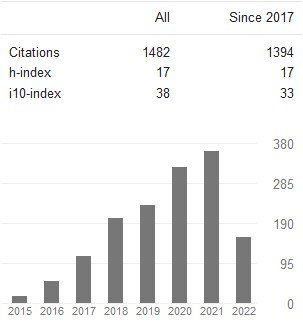Biosynthesis and antioxidant activity of single cell carotenoids extracted from microbial cultures
Abstract
Single cell carotenoids (SCC) as microbial metabolite was produced by a growing culture of yeasts (Phaffia rhodozyma and Rhodotorula minuta) and molds (Neurospora sitophylla and Monascus purpureus) in coconut water medium containing sucrose. The highest single cell carotenoid levels had been exhibited by culture of P. Rhodozyma after incubation for 168 h was approximately 46.12 µg/g, whereas it was shown by M. purpureus, R. minuta and N. sitophila were 25.30 µg/g, 14.72 µg/g and 12.50 µg/g, respectively. IC50 of 9.9896 µg/ml was shown by decreasing in absorption of DPPH for each sample of the tested samples that was measured at every 5 min for 30 min of observation. Although there was a decrease in absorbance, however, the antioxidant activity of crude SCC derived from culture of N. sitophila was 22 times lower compared to the antioxidant activity of vitamin C as a positive control, however, it was higher than the antioxidant activity of the crude SCC derived from culture of P. rhodozyma, M. purpureus, and R. minuta. This study was to provide important basic knowledge on physiological aspects of the biosynthesis of SCC derived from microbial cultures and to assay their antioxidant activities dealing with their potential properties as an alternative source for natural antioxidant
Keywords:
Single cells carotenoid, Microbial culture, Biosynthesis, Antioxidant ActivityDownloads
Published
How to Cite
Issue
Section
Copyright (c) 2016 Joko Sulistyo, Rini Handayani, Yati Sudaryati Soeka

This work is licensed under a Creative Commons Attribution-NonCommercial-ShareAlike 4.0 International License.



 Journal of Innovations in Pharmaceutical and Biological Sciences is licensed under a Creative Commons Attribution-NonCommercial-ShareAlike 4.0 International License. Based on a work at
Journal of Innovations in Pharmaceutical and Biological Sciences is licensed under a Creative Commons Attribution-NonCommercial-ShareAlike 4.0 International License. Based on a work at